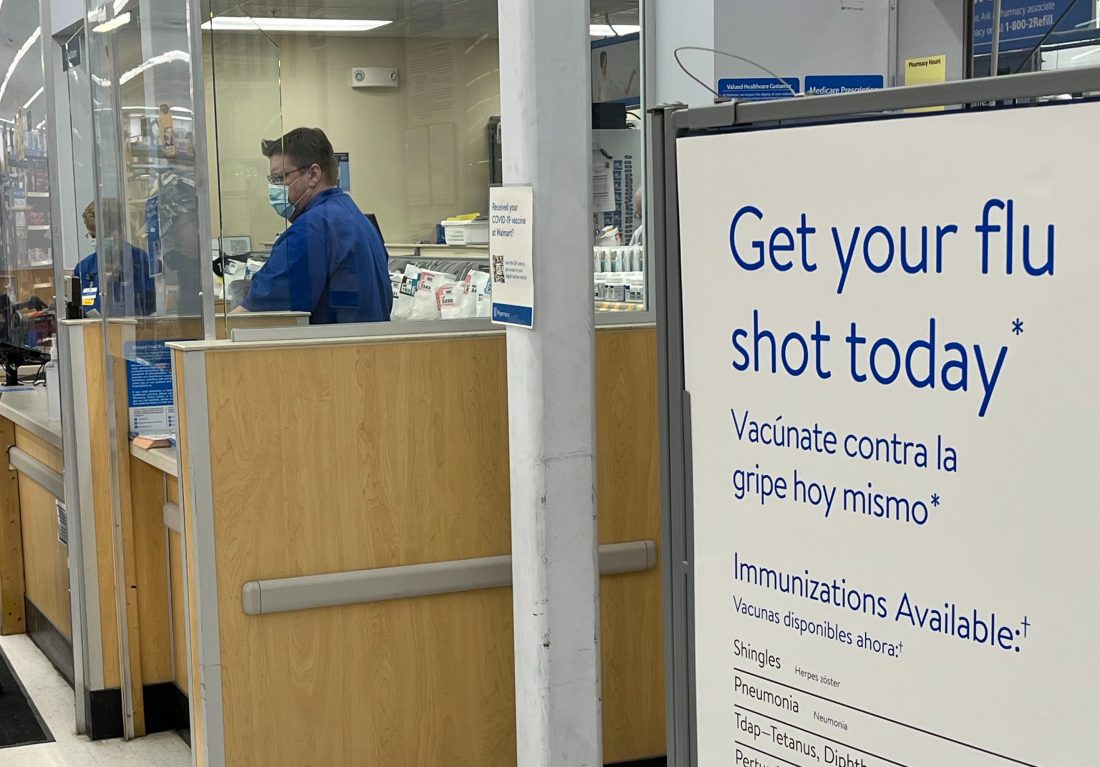Michigan flu numbers lower than national average, but vaccines still recommended

News photo by Steve Schulwitz Pharmacy workers on Wednesday help customers at the Alpena Walmart pharmacy, which offers flu vaccinations.
ALPENA — Despite a lower number of influenza cases in Michigan compared to other states this flu season, local public health officials urge anyone who can get a flu shot to do so.
According to John MacMaster, chief medical officer for Alcona Health Center, Michigan has had lower Influenza cases this season compared to other states.
“We have been seeing some flu, but a lot more COVID,” MacMaster said. “You don’t have to choose between the two (vaccines), you should get both,” MacMaster said. “The flu is real and it is different from COVID-19, but it is a very serious illness, especially for babies and older people.”
Local public health officials recently said they didn’t see many flu cases in Northeast Michigan last flu season, but said the flu, strep throat and other viruses that have rarely been discussed over the past two years are making a comeback.
“Influenza is actively increasing across the country,” Medical Director Joshua Meyerson said during a District Health Department No. 4 meeting last month. “We are seeing a lot of other viruses going around, it’s not all COVID. It’s kind of hard to tell which one it is without being tested.”
The Michigan Department of Health and Human Services reports the same trend elsewhere, though Michigan remains below the national baseline.
MDHHS reports that, as of the week ending Jan. 8, 4.3% of outpatient visits in the U.S. were for influenza-like illness, which is above the national baseline of 2.5%. In that same timeframe, Michigan’s percentage of influenza-like illness was 1.8%
The national baseline is developed by calculating the percentage of flu-related patient visits during non-influenza weeks for the most recent three seasons.
Influenza-like illness is defined as a fever of higher than 100 degrees and a cough or sore throat without a known cause other than influenza.
During the same week last year, MDHHS reported 1.6% of outpatient visits were flu-related, well below the baseline of 2.6%. In that same timeframe, Michigan’s percentage of influenza-like illness was 0.3%
MacMaster said he hasn’t seen any of the combination flu and COVID-19 together, but said flu symptoms and COVID-19 symptoms are very similar and hard to tell apart.
“Clinical signs and symptoms are virtually identical,” MacMaster said. “We have to scan for both.”
MacMaster said Alcona Health Center is seeing some cases of strep throat – which is a bacterial infection that also tends to be seasonal – but fewer than normal. He attributes some of that to people using more caution in protecting themselves from COVID-19.
According to the U.S. Centers for Disease Control and Prevention, the majority of influenza cases currently being diagnosed stem from the H3N2 virus.
The CDC said H3N2 viruses are genetically similar to the vaccine virus, making the vaccine effective in protecting against it.
Vaccination provides the best protection from the flu, the agency said, suggesting flu vaccinations for every resident older than six months.
The vaccine for the 2021-2022 flu season is designed to protect against four flu viruses ― A(H1N1), A(H3N2), and two flu B viruses.
MDHHS officials hope to vaccinate 4 million Michigan residents during the 2021-2022 flu season. As of Jan. 8, state health officials had administered 2.9 million doses and considered their goal 75% reached.
Although the duration of the flu season is difficult to predict, according to MDHHS, it usually peaks around February and continues through May.






